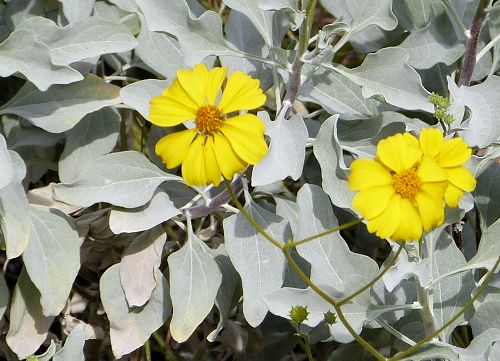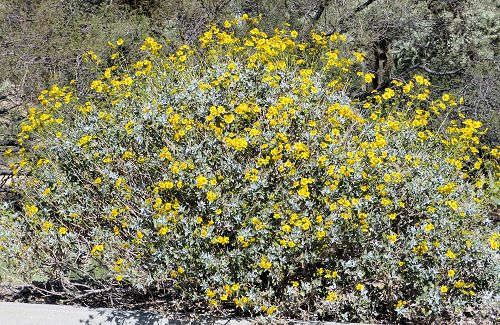Growing Encelia farinosa:
Brittlebush
Description
Form: Shrub.
Leaf retention: Winter evergreen but drought- and frost-deciduous.
Growth rate: Rapid.
Mature Size: 3-5' (1-1.5m) high and wide.
Flowers: Yellow rays, with orange to brown florets in the center, on tall stalks above the leaves.
Bloom: Mid-fall, through winter, to mid-spring.
Fruit: Each floret produces one dried fruit with a single seed (cypsela), tufted at one end, which is dispersed by the wind.
Leaves: Triangular to oval, silvery blue-green, covered in fine hairs.
Stems: Covered in fine white hairs, brittle and easily broken. An aromatic resin seeps from the ends of broken stems. No thorns,
Roots: Wide and shallow, with a deep taproot. This plant is very difficult to transplant.
Wildlife: The flowers attract bees and butterflies, especially when nothing else is blooming. It is browsed by deer and bighorn sheep, but is not a useful forage for cattle.
Toxic / Danger: Not to animals or humans. This plant is allelopathic and its leaves produce a water-soluble substance that inhibits the growth of some winter annual plants. It competes strongly with buffalo grass.
Origin: California, Nevada, Arizona, Utah, Mexico.
Form: Shrub.
Leaf retention: Winter evergreen but drought- and frost-deciduous.
Growth rate: Rapid.
Mature Size: 3-5' (1-1.5m) high and wide.
Flowers: Yellow rays, with orange to brown florets in the center, on tall stalks above the leaves.
Bloom: Mid-fall, through winter, to mid-spring.
Fruit: Each floret produces one dried fruit with a single seed (cypsela), tufted at one end, which is dispersed by the wind.
Leaves: Triangular to oval, silvery blue-green, covered in fine hairs.
Stems: Covered in fine white hairs, brittle and easily broken. An aromatic resin seeps from the ends of broken stems. No thorns,
Roots: Wide and shallow, with a deep taproot. This plant is very difficult to transplant.
Wildlife: The flowers attract bees and butterflies, especially when nothing else is blooming. It is browsed by deer and bighorn sheep, but is not a useful forage for cattle.
Toxic / Danger: Not to animals or humans. This plant is allelopathic and its leaves produce a water-soluble substance that inhibits the growth of some winter annual plants. It competes strongly with buffalo grass.
Origin: California, Nevada, Arizona, Utah, Mexico.
Cultivation and Uses
USDA hardiness zones: 7-10 in arid regions. This plant may die to the ground during a freeze and grow back from its roots in the spring.
Heat tolerant: Yes.
Drought tolerant: Yes.
Sun: Full sun.
Soil: Very well draining, dry, low organic content, pH 6.6-8.5 (neutral to alkaline).
Water once established: Monthly. Overwatering causes excessive growth.
Prune: After flowering, trim tall flower stalks down to leaf level. Deadheading spent flowers reduces reseeding. The plant can be cut to near ground level in mid-spring to avoid a shaggy summer appearance. It is easily eradicated by pulling it up with its taproot.
Litter: Low except for pruning.
Propagation: Seed. This plant reseeds freely and can form a thicket depending on the amount of rainfall it receives.
Uses: Ornamental, low water (xeriscape) garden, erosion control on level ground and modest slopes. Its aromatic resin is burned as incense, and the aroma has been compared to that of frankincense. It has also been used as chewing gum, a glue, and to waterproof containers.
USDA hardiness zones: 7-10 in arid regions. This plant may die to the ground during a freeze and grow back from its roots in the spring.
Heat tolerant: Yes.
Drought tolerant: Yes.
Sun: Full sun.
Soil: Very well draining, dry, low organic content, pH 6.6-8.5 (neutral to alkaline).
Water once established: Monthly. Overwatering causes excessive growth.
Prune: After flowering, trim tall flower stalks down to leaf level. Deadheading spent flowers reduces reseeding. The plant can be cut to near ground level in mid-spring to avoid a shaggy summer appearance. It is easily eradicated by pulling it up with its taproot.
Litter: Low except for pruning.
Propagation: Seed. This plant reseeds freely and can form a thicket depending on the amount of rainfall it receives.
Uses: Ornamental, low water (xeriscape) garden, erosion control on level ground and modest slopes. Its aromatic resin is burned as incense, and the aroma has been compared to that of frankincense. It has also been used as chewing gum, a glue, and to waterproof containers.
Comments
This plant is a member of the Daisy family (Asteraceae).
Do you have additional information or a different experience for these plants that you would like to share? Email info@GardenOracle.com. All contributions are welcome and appreciated.
This plant is a member of the Daisy family (Asteraceae).
Do you have additional information or a different experience for these plants that you would like to share? Email info@GardenOracle.com. All contributions are welcome and appreciated.


Latest update: March, 2024
© 2008-2025 by GardenOracle.com

